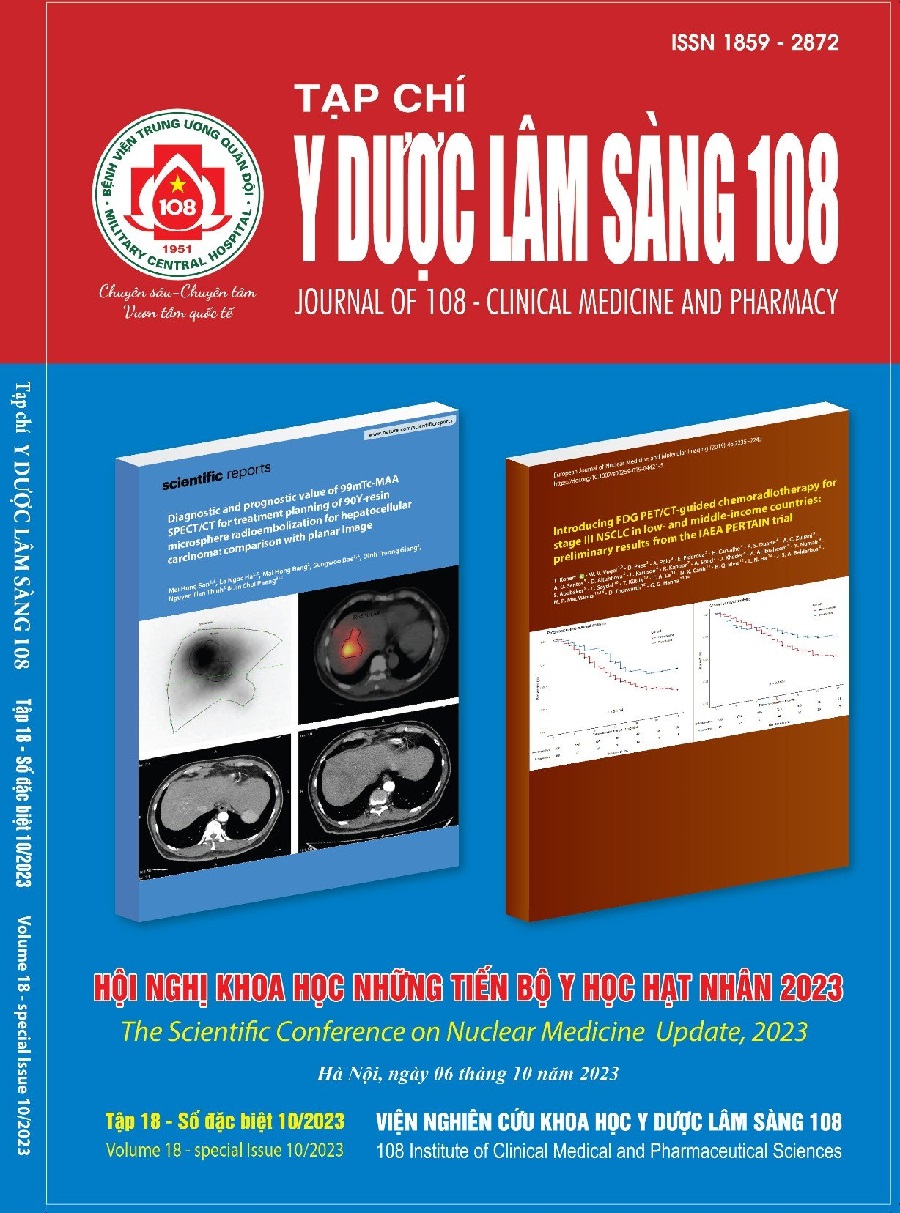Effectiveness of using deep learning model with attenuation correction in myocardial perfusion imaging by SPECT
Main Article Content
Keywords
Abstract
Objective: To evaluate the effectiveness of using deep learning model with attenuation correction in SPECT myocardial perfusion imaging. Subject and method: Use the 3DUnet-GAN network to attenuation correction for SPECT without attenuation correction (NC) images to generate attenuation corrected (AC) SPECT images. The image generated from the AI model is compared with the SPECT/CT image (TrueAC). Compare and evaluate the results of the model used with ResNet model and Chang AC method, the coefficient of uniform decline in body contour. Evaluate model-generated images with clinical effectiveness. Result: Overall, the deep learning solution exhibited good agreement with the CT-based AC, noticeably outperforming the Chang method. The ResNet and 3DUNet-GAN models resulted in the ME (count) of -6.99 ± 16.72 and -4.41 ± 11.8 and SSIM of 0.99 ± 0.04 and 0.98 ± 0.05, respectively. While the Chang approach led to ME and SSIM of 25.52 ± 33.98 and 0.93 ± 0.09, respectively. Similarly, the clinical evaluation revealed a mean TPD of 12.21 ± 8.28 and 12.00 ± 9.21 for the ResNet and UNet models, respectively, compared to 11.95 ± 9.37 obtained from the reference SPECT CT-AC images. On the other hand, the Chang approach led to a mean TPD of 14.26 ± 8.19. Conclusion: The method of using computer deep learning to attenuation correction SPECT images potential to be used for facilities that only use SPECT machines, assisting doctors in diagnosing images and reducing the pressure on work intensity for medical staff.
Article Details
References
2. Fihn SD, Gardin JM, Abrams J, Berra K, Blankenship JC, Dallas AP, Douglas PS, Foody JM, Gerber TC, Hinderliter AL, King SB 3rd, Kligfield PD, Krumholz HM, Kwong RY, Lim MJ, Linderbaum JA, Mack MJ, Munger MA, Prager RL, Sabik JF, Shaw LJ, Sikkema JD, Smith CR Jr, Smith SC Jr, Spertus JA, Williams SV; American College of Cardiology Foundation (2012) 2012 ACCF/AHA/ACP/AATS/PCNA/SCAI/STS guideline for the diagnosis and management of patients with stable ischemic heart disease: executive summary: a report of the American College of Cardiology Foundation/American Heart Association task force on practice. Circulation 126(25): 3097-137.
3. Task Force Members; Montalescot G, Sechtem U, Achenbach S, Andreotti F, Arden C, Budaj A, Bugiardini R, Crea F, Cuisset T, Di Mario C, Ferreira JR, Gersh BJ, Gitt AK, Hulot JS, Marx N, Opie LH, Pfisterer M, Prescott E, Ruschitzka F, Sabaté M, Senior R, Taggart DP, van der Wall EE, Vrints CJ; ESC Committee for Practice Guidelines; Zamorano JL, Achenbach S, Baumgartner H, Bax JJ, Bueno H, Dean V, Deaton C, Erol C, Fagard R, Ferrari R, Hasdai D, Hoes AW, Kirchhof P, Knuuti J, Kolh P, Lancellotti P, Linhart A, Nihoyannopoulos P, Piepoli MF, Ponikowski P, Sirnes PA, Tamargo JL, Tendera M, Torbicki A, Wijns W, Windecker S; Document Reviewers; Knuuti J, Valgimigli M, Bueno H, Claeys MJ, Donner-Banzhoff N, Erol C, Frank H, Funck-Brentano C, Gaemperli O, Gonzalez-Juanatey JR, Hamilos M, Hasdai D, Husted S, James SK, Kervinen K, Kolh P, Kristensen SD, Lancellotti P, Maggioni AP, Piepoli MF, Pries AR, Romeo F, Rydén L, Simoons ML, Sirnes PA, Steg PG, Timmis A, Wijns W, Windecker S, Yildirir A, Zamorano JL (2013) 2013 ESC guidelines on the management of stable coronary artery disease: The Task Force on the management of stable coronary artery disease of the European Society of Cardiology. Eur Heart J 34(38):2949-3003. doi: 10.1093/eurheartj/eht296.
4. Schuijf JD, Poldermans D, Shaw LJ, Jukema JW, Lamb HJ, de Roos A, Wijns W, van der Wall EE, Bax JJ (2006) Diagnostic and prognostic value of non-invasive imaging in known or suspected coronary artery disease. Eur J Nucl Med Mol Imaging 33(1):93-104. doi: 10.1007/s00259-005-1965-y.
5. Erin McNemar M (2022) How can artificial intelligence change medical imaging? Healthitanalytics.
6. Verberne HJ, Acampa W, Anagnostopoulos C, Ballinger J, Bengel F, De Bondt P, Buechel RR, Cuocolo A, van Eck-Smit BL, Flotats A, Hacker M, Hindorf C, Kaufmann PA, Lindner O, Ljungberg M, Lonsdale M, Manrique A, Minarik D, Scholte AJ, Slart RH, Trägårdh E, de Wit TC, Hesse B; European Association of Nuclear Medicine (EANM) (2015) EANM procedural guidelines for radionuclide myocardial perfusion imaging with SPECT and SPECT/CT: 2015 revision. Eur J Nucl Med Mol Imaging 42(12): 1929-1940. doi: 10.1007/s00259-015-3139-x.
7. Trung Thanh Nguyen, Thanh Nguyen Chi, Minh Dang Hoang, Ha Nguyen Thai, Thuan Nguyen Duc, (2020) 3D Unet Generative Adversarial Network for Attenuation Correction of SPECT Images. IEEE. DOI: 10.1109/SigTelCom49868.2020.9199018.
8. Mostafapour S, Gholamiankhah F, Maroofpour S, Momennezhad M, Asadinezhad M, Zakavi SR, Arabi H (2021) Deep learning-based attenuation correction in the image domain for myocardial perfusion SPECT imaging. Medical Physics.
9. Lee-Tzuu Chang (1978) A method for attenuation correction in radionuclide computed tomography. IEEE Trans Nucl Sci 25: 638-643.
 ISSN: 1859 - 2872
ISSN: 1859 - 2872
